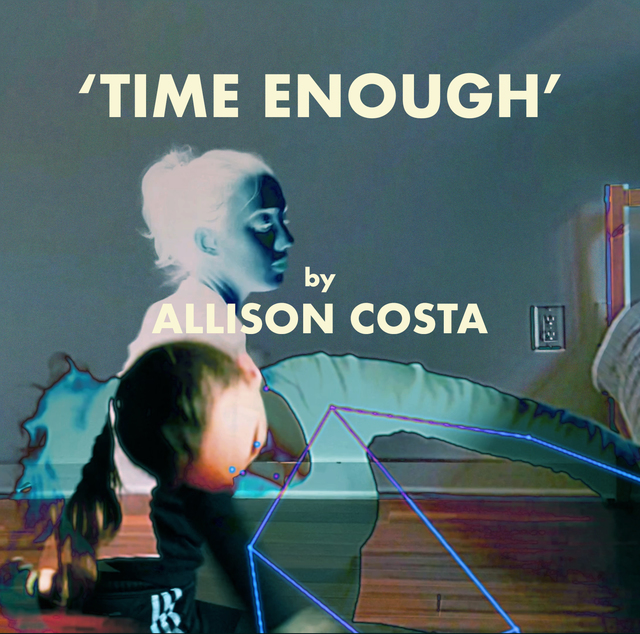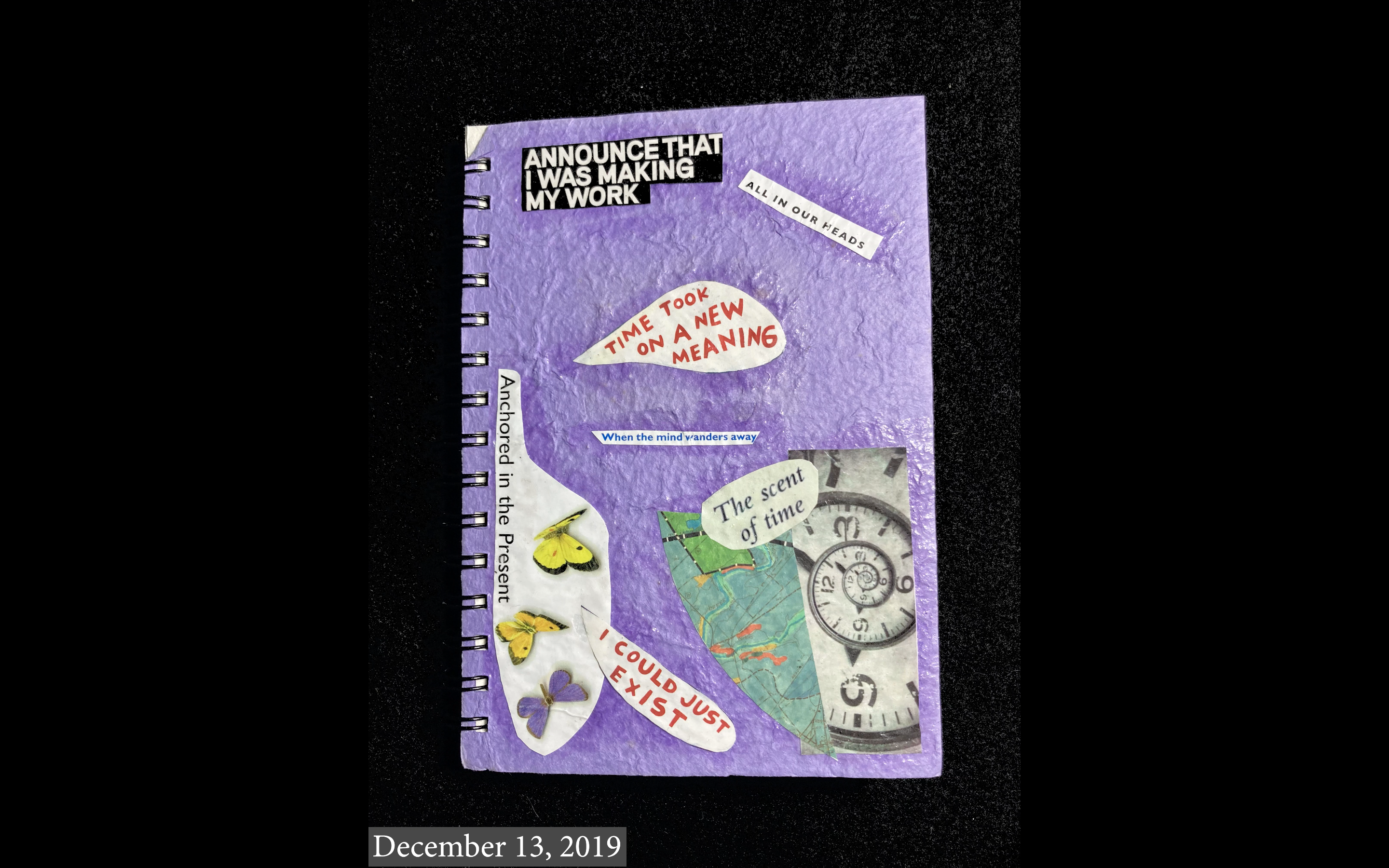Time Enough | Allison Costa
a creative research project on our perception and experience of time
“Time Enough” is a creative research project studying our perception and experience of time through dance and technology. The piece is composed of 10 smaller-scale experiments (or “clocks,” if you will) each depicting a different element of the research. The layering and juxtaposition of these “clocks” points to a deeper narrative about time and its fluidity depending on context and perspective.
“Time Enough” presents my yearlong creative research project studying our perception and experience of time through dance and technology. The work is composed of 10 smaller-scale experiments (or “clocks,” if you will) each depicting a different element of my research. The layering and juxtaposition of these “clocks” points to a deeper narrative about time and its fluidity depending on context and perspective.
Each “clock” is comprised of 3 parts: an autoethnographic art piece (shown as images or video), an interactive element, and text. These parts are valued equally, with the hope of conveying the same material or questions through each in such a way that they build upon each other but can also stand on their own. The reason for the three different types of engagement, is to let viewers choose how they wish to interact. The attempt to translate somatic practice to an online space is complicated and different for each body. I believe providing choice for modes of interaction and engagement honors this complexity and is particularly important at a time when choices seem frustratingly limited.
Since there is no “right” way of experiencing this project or time itself, the research presented does not conclude in answers, but in questions. The goal is simply to spend some time considering how you experience time. Perhaps just by taking time here and now, you will change your experience of it. I know my perception of time has definitely changed due to my research.
Credit for production, choreography, dance, computer code, videography, photography, editing, poetry, text, collage, and sound design: Allison Costa, unless otherwise specified
December 2019-April 2021: Art Journal
resource series
I began my creative research by starting an artist’s journal, in addition to my private journaling practice. This journal helped keep track of resources, references, and thoughts. About once a month I created a collage (which is the part of the journal I have chosen to share) to reflect on my research and my recent experience of time. Collectively, they illuminate the larger narrative of my research and help place it in the context of the time when it was created. How can time function not only as part of the content or subject matter but also as a medium through which I explore and understand life?
July 2020: Time and Space
resource series
This clock focuses on the relationship between Time and Space. Exploring concepts of Einstein’s famous theory of spacetime, known technically as tensor mathematics, I used PoseNet, a pose estimation software using TensorFlow.js, for my autoethnographic research on how our experience of time changes when moving within or beyond boundary boxes. This felt particularly apt during a time when many of us were mostly homebound. If the relative nature of space and time is due to the entanglement of their perception, how is my perception related to the time and space I inhabit?
September 2020: Time Perspective
resource series
This clock explores how one’s sense of time changes based on perspective. The layering is to demonstrate how changes in perspective can either be an individual’s perspective over time or a result of interacting with other people or forces. I chose the overhead view to illustrate the depth of time or perhaps the perspective of time itself. As Byung-Chul Han states in “The Scent of Time,” “Time deepens vertically instead of stretching along the horizontal narrative path.” The echoing quality of my dancing body, however, breaks up the temporal and narrative continuity, as events no longer have a clear sequence and the past and future of the dance are all being shown in the present. This is what Byung-Chul Han calls “time without scent” or “non-time,” which he attributes to the growing atomization of life and identity, especially with the rise of technology. These factors complicate people’s ability to maintain or change their temporal perspectives.
October 2020: Time Past and Time Future
resource series
I created this clock based on T. S. Eliot's “Four Quartets,” which explores the idea of time being eternally present, or “Time present and time past / Are both perhaps present in time future, / And time future contained in time past.” The first poem “Burnt Norton” depicts everything in constant flux, questioning how to be present when time is constantly moving and the present is always what just was the future and just will be the past. It embraces paradox to depict the dialectic nature of time, lived experience, and deeper philosophic questions about meaning of time. In my creative work to explore this idea, I chose to create a split screen dance to illustrate the interaction between Eliot’s dual natures of time. I intended the choreography for each side of the screen to both reflect and contrast, highlighting the theme of echo in T.S. Eliot’s work, where all time is a repetition of other times and has a reverberation or continuing effect. This dichotomy of being the same and yet new drove me to explore my next “clock” entitled “November 2020: Looptime”. When I try to stay present in the “now” am I denying time’s interconnectedness or honoring its ever-changing nature?
November 2020: Looptime
resource series
This clock was inspired by a performance entitled “Soundz at the Back of My Head” by Thomas DeFrantz/slippage, in which DeFrantz coined the term “looptime,” describing it as “repetition with a difference or the ever-changing same (but always different).” Using PoseNet pose estimation software, I experimented to try to understand how our perception of movement, which is intrinsically related to time, changes through the filter of applied technology. The PoseNet footage is a repeated dance phrase, where the choreography itself creates a loop, exploring how our experience of motion (and thus time) changes depending on the moment and the lens through which we see it. This makes time circular rather than linear and suggests that temporal tension created by clearly designating a timeline of past, present, and future (lauded by much of my research as the way to find meaning in time) is an individualistic perspective on a greater cyclical vision of time where all pasts, presents, and futures can relate and build upon one another. How do I need to shift my thinking to value to the same extent re-mixing and innovation?
November 2020: Sensing Time
resource series
Utilizing a sound creation app by Brian Eno and Peter Chilvers entitled “Trope,” I created a soundscape based on timed visuals and then danced to the soundscape. I layered these recordings to explore how my perception of time changed based on what senses I was using: sight, sound, touch, and proprioception. Since perception is the process by which the brain selects, organizes, and interprets sensory feedback, I decided to compare how (some of) my sensory receptors interacted with time-based input. How do I stay conscious to the passing of time when sensation is innate?
January 2021: Crystal of Time
resource series
I created this clock to explore the idea of time as a crystal. A very rudimentary description of a time crystal is a 4-dimensional theoretical model in physics. One’s experience of a crystal changes based on one’s orientation in relation to the crystal as well as in a larger context, such as the time of day, which all affect how the crystal’s reflected and transmitted light will appear. Similarly, one’s experience of time changes based on one’s relation to time and one’s larger context; age, history, future plans, perspective, etc. all affect how time is perceived. How much of my research reflects more intrinsic elements of time and how much is influenced by who I am and my current context?
February 2021: Time as Self
resource series
In this clock I investigated how sense of time is related to sense of self. Since people have finite lifetimes and with that an intrinsic internal timing, some of my research equated one’s perception of self to one’s perception of time. What one spends time on determines what one’s lifetime is built upon. This draws into focus the direct relationship between how one understands what they do as part of who they are, with how one understands and experiences time. For this experiment I focused on parts of my daily life to illustrate how not only my perception of time but also my lifetime so far is reflected in how I spend my time each day. Is my perception of self determined by what I perceive to spend my time on or by the actual quantity of time I spend?
February 2021: Grand Narratives
resource series
Harkening back to the split-screen clock “October 2020: Time Past and Time Future,” this clock used the split-screen to explore the idea of “grand narratives,” which kept popping up in my research. A “grand narrative” is a contextualization of the past, present, and future that affects our understanding of and relationship to a bigger sense of time than our individual lifetimes. The temporal tension of “grand narrative” was proposed as a solution to “non-time” (mentioned in “September 2020: Time Perspective”), which is created by the atomization of time due to increasingly radical individualization, and leads to the perception of time accelerating or, more accurately, speeding without direction due to lack of narrative. So, for this experiment, I took a poem I wrote about time, turned the text into sound using software for electronically composing music, and experimented with how the narrative affected my movement. The split- screen was important to reference theories about the origins of time, where time evolution seems to come straight out of symmetries and singularities in the cosmos. Tying my individual, written narrative to a larger narrative about time’s origins deepened my creative exploration into how a bigger contextualization changes one’s experience of time. How do I balance my desire for independence and personal narrative with my belief in global-thinking community and mutual aid?
October 2020-April 2021: Seasonal Time
resource series
This clock represents my research on how our internal clocks, that dictate our perception and experience of time, interact with external natural factors (like seasons and weather), which are themselves clocks. These photographs were taken on my walks to and from work. This routine, which enabled the durational element of this experiment, is in many ways like an individualized clock. The regularity and consistency of a routine provides a measured timing. The pictures of this experiment illustrate changes in my internal clock of routine in comparison to changes in the external clock of nature. What can I do to not be blinded to nature’s clocks when so many of my routines where built without regard or even purposefully against them?

